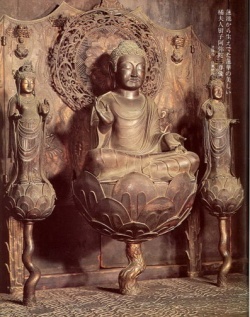Indian transplants: tathāgatagarbha and Yogācāra
A dispute at the start of the sixth century presaged a conflict that would take the Chinese Buddhists more than two centuries to settle.
Two Indian monks collaborated on a translation of Vasubandhu’s Daśabhūmikasūutra śāstra (Treatise on the Ten Stages Sutra; in Chinese, Shidijing lun, or Dilun for short).
The Dilun described the ten stages through which a bodhisattva proceeded on the way to nirvāṇa, and Vasubandhu’s exposition of it highlighted aspects most in accord with the tenets of the Yogācāra school (see Buddhism, Yogācāra school of; Vasubandhu).
While translating, an irreconcilable difference of interpretation broke out between the two translators, Bodhiruci and Ratnamati. Bodhiruci’s reading followed a relatively orthodox Yogācāra line, while Ratnamati’s interpretation leaned heavily toward a Buddhist ideology only beginning to receive attention in China, tathāgatagarbha thought.
Bodhiruci went on to translate roughly forty additional texts, and was later embraced by both the Huayan and Pure Land traditions as one of their early influences (see §§8, 10). Ratnamati later collaborated with several other translators on a number of other texts.
Both sides attempted to ground their positions on interpretations of key texts, especially the Dilun.
The Yogācāra versus Yogācāra-tathāgatagarbha conflict became one of the critical debates amongst sixth and seventh century Chinese Buddhists.
Yogācāra focused on the mind and distinguished eight types of consciousness:
five sensory consciousnesses;
an empirical organizer of sensory data (mano-vijñāna);
a self-absorbed, appropriative consciousness (manas); and
the eighth, a warehouse consciousness (ālaya-vijñāna) that retained the karmic impressions of past experiences and coloured new experiences on the basis of that previous conditioning.
The eighth consciousness was also the fundamental consciousness.
Each individual is constituted by the karmic stream of one’s own ālaya-vijñāna, that is, one’s karmic conditioning.
Since, like a stream, the ālaya-vijñāna is reconfigured each moment in response to constantly changing conditions, it is not a permanent self, although, being nothing more than a sequential chain of causes and effects, it provides sufficient stability for an individual to maintain a sense of continuity.
According to classical Yogācāra texts, the mind (that is, ālaya-vijñāna and the mental events associated with it) is the problem, and enlightenment results from bringing this consciousness to an end, replacing it with the Great Mirror Cognition (ādarśa-jñāna);
instead of discriminating consciousness, one has direct immediate cognition of things just as they are, as impartially and comprehensively as a mirror. This type of enlightenment occurs during the eighth stage according to the Dilun and other texts.
The term tathāgatagarbha (in Chinese, rulaizang) derives from two words: tathāgata (Chinese, rulai) is an epithet of the Buddha, meaning either ‘thus come’ or ‘thus gone’; garbha means embryo, womb or matrix, and was translated into Chinese as zang, meaning ‘repository’.
In its earliest appearances in Buddhist texts, tathāgatagarbha (repository of buddhahood) signified the inherent capacity of humans (and sometimes other sentient beings) to achieve buddhahood.
Over time the concept expanded and came to signify the original pristine pure ontological Buddhaness intrinsic in all things, a pure nature that is obscured or covered over by defilements (Sanskrit, kleśa;
Chinese fannao), that is, mental, cognitive, psychological, moral and emotional obstructions.
It was treated as a synonym for Buddha-nature, though Buddha-nature dynamically understood as engaged in a struggle against defilements and impurities.
In Chinese Buddhism especially, the soteriological goal consisted in a return to or recovering of that original nature by overcoming or eliminating the defilements.
The battle between the pure and impure, light and dark, enlightenment and ignorance, good and evil and so on, took on such epic proportions in Chinese Buddhist literature that some scholars have compared it to Zoroastrian or Manichean themes, though evidence for the influence of those religions on Buddhist thought has been more suggestive than definitive (see Manicheism; Zoroastrianism).
In their classical formulations the ālaya-vijñāna and tathāgatagarbha were distinct items differing from each other in important ways – for instance, enlightenment entailed bringing the ālaya-vijñāna to an end, while it meant actualizing the tathāgatagarbha;
the ālaya-vijñāna functioned as the karmic mechanism par excellence, while tathāgatagarbha was considered the antipode to all karmic defilements.
Nonetheless some Buddhist texts, such as the Laṅkāvatāra Sūtra, conflated the two.
Those identifying the two argued that the ālaya-vijñāna, like tathāgatagarbha, was pure and its purity became permanently established after enlightenment.
Those opposing the conflation countered that the ālaya-vijñāna was itself defiled and needed to be eliminated in order to reach enlightenment.
For the conflators, tathāgatagarbha was identified with Buddha-nature and with mind (xin) (see Xin).
Mind was considered pure, eternal, and the ontological ground of reality (Dharma-dhātu), while defiled thought-instants (nian) that engaged in delusionary false discriminations had to be eliminated.
Once nian were eliminated, the true, pure nature of the mind would brilliantly shine forth, like the sun coming out from behind the clouds.
A third view was added when Paramārtha, another Indian translator with his own unique interpretation of Yogācāra, arrived in the middle of the sixth century.
For his followers the most important of his translations was the She dasheng lun (Sanskrit title, Mahāyānasaṃgraha), or Shelun, a quasi-systematic exposition of Yogācāra theory by one its founders, Asaṅga.
In some of his translations he added a ninth consciousness beyond the usual eight, a ‘pure consciousness’ that would pervade unhindered once the defiled ālaya-vijñāna was destroyed.
His translations, which sometimes took liberties with the Sanskrit originals, offered a more sophisticated version of the conflation theory.
Source
LUSTHAUS, DAN (1998). Buddhist philosophy, Chinese. In E. Craig (Ed.), Routledge Encyclopedia of Philosophy. London: Routledge. Retrieved May 21, 2013, from http://www.rep.routledge.com/article/G002SECT4

